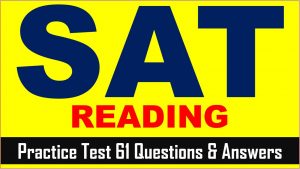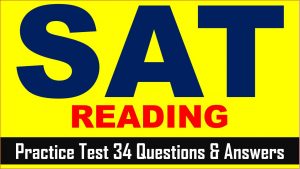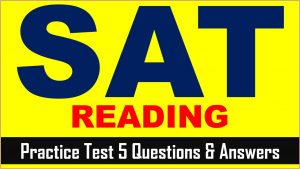Hi SAT Aspirants, welcome to AKVTutorials. As you know SAT (Scholastic Assessment Test) is a standard test, used for taking admission to undergraduate programs of universities or colleges of United States. SAT is developed and published by the College Board, an organization in United States, administered by the Educational Testing Service. Are you searching for SAT Reading Practice Questions? Then, in this article of AKVTutorials, you will get SAT Reading Prep Test 57 | SAT 2023 Online Course AMBiPi.
SAT Reading Practice Passage
SAT Reading Practice Test Comprehensive Passage
This passage is adapted from David Graeber, “To Have is to owe” by Melville Publishing. The following 10 multiple choice questions are based on the passage below.
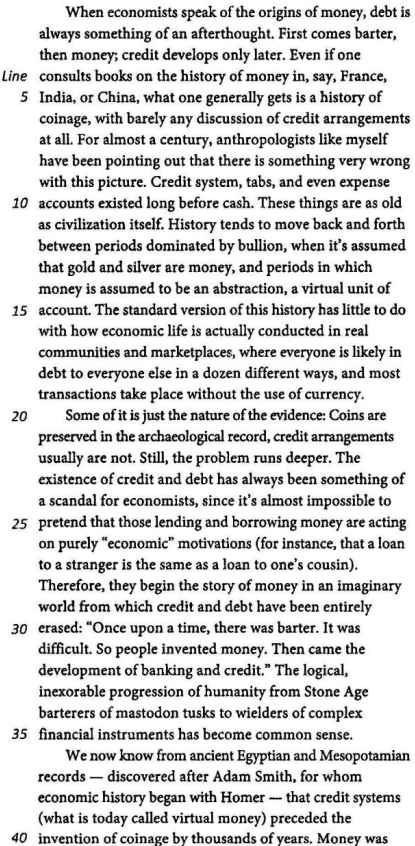
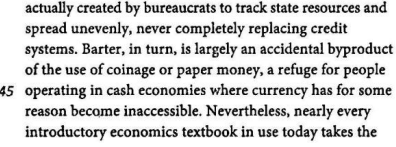
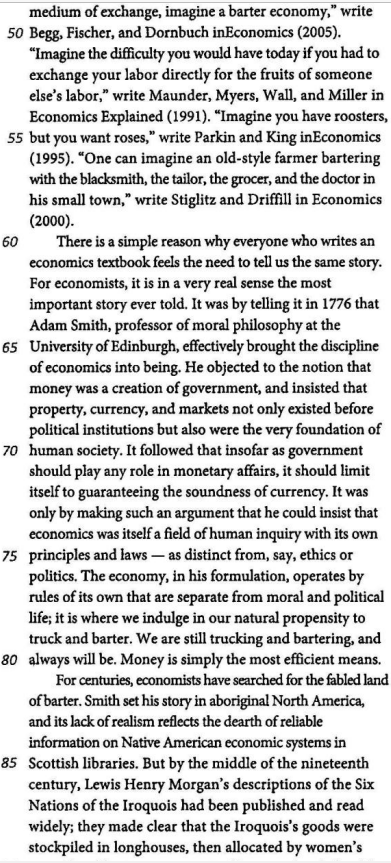
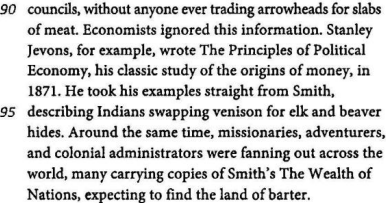
SAT Reading Comprehension Practice Test Questions
SAT Reading Practice Test Question No 1
The first paragraph serves primarily to
Option A : explain how an anthropology research is completed.
Option B : note a common misconception about the debt.
Option C : present a natural phenomenon of scientific importance.
Option D : describe a recent study on rare metals as currency.
SAT Practice Test Answer No 1
Show/Hide Answer
Option C : present a natural phenomenon of scientific importance.
SAT Reading Practice Test Question No 2
Which choice best summarizes the general idea of the passage as a whole?
Option A : It refutes a commonly held belief that money predates the debt with analysis into the origin of this misconception.
Option B : It supports the general claim that the invention of currency greatly facilitates the social and economic development.
Option C : It argues that the discipline of economics is actually a human invention with its distinct law and regularity.
Option D : It presents the historical figures and sources as support to the idea that barter is indeed a fabled land.
SAT Practice Test Answer No 2
Show/Hide Answer
Option D : It presents the historical figures and sources as support to the idea that barter is indeed a fabled land.
SAT Reading Practice Test Question No 3
According to the passage, the author would most likely to object to which of the following about credit arrangement?
Option A : Adam Smith’s theories can hardly apply to today’s credit market and ethical behavior.
Option B : Credit system coexists with human civilization and most political conventions.
Option C : It is recognized that money is an abstraction, or more aptly, a virtual unit of account.
Option D : The creation of currency predates the credit system in human history of civilization.
SAT Practice Test Answer No 3
Show/Hide Answer
Option A : Adam Smith’s theories can hardly apply to today’s credit market and ethical behavior.
SAT Reading Practice Test Question No 4
Which choice provides the best support to answer for the previous question?
Option A : Lines 1-7 (“When…all”)
Option B : Lines 9-11 (“Credit… itself”)
Option C : Lines 11-15 (“History…account”)
Option D : Lines 20-26 (“Some…motivations”)
SAT Practice Test Answer No 4
Show/Hide Answer
Option D : Lines 20-26 (“Some…motivations”)
SAT Reading Practice Test Question No 5
In line 9,”picture” can be best replaced by
Option A : portrait.
Option B : fable.
Option C : account.
Option D : story.
SAT Practice Test Answer No 5
Show/Hide Answer
Option A : portrait.
SAT Reading Practice Test Question No 6
The main purpose of the second paragraph is to
Option A : present the realistic model used by the economists to discuss the monetary values and debts.
Option B : develop a counterargument to the claim that debt is invented before money.
Option C : provide some supports for the idea that money is something of pure imagination.
Option D : illustrate that lack of historical evidence causes economists to deliberately ignore the debt and credit.
SAT Practice Test Answer No 6
Show/Hide Answer
Option C : provide some supports for the idea that money is something of pure imagination.
SAT Reading Practice Test Question No 7
In line 33, the word “progression most closely means
Option A : advancement.
Option B : improvement.
Option C : transformation.
Option D : alteration.
SAT Practice Test Answer No 7
Show/Hide Answer
Option B : improvement.
SAT Reading Practice Test Question No 8
Which choice best supports the author’s claim that the barter actually didn’t precede the credit system as described in the passage?
Option A : Lines 9-11 (“Credit… itself”)
Option B : Lines 15-19 (“The…currency)
Option C : Lines 28-35 (“Therefore…sense”)
Option D : Lines 40-46 (“Money…inaccessible”)
SAT Practice Test Answer No 8
Show/Hide Answer
Option B : Lines 15-19 (“The…currency)
SAT Reading Practice Test Question No 9
The passage describes the approaches of several introductory economics books in lines 46-58 primarily in order to
Option A : highlight how common it is for economists now to accept the concept that credit originates from barter.
Option B : pinpoint the exact concept that has been so widely used by normal economists in academic institutions.
Option C : contrast and compare there approaches to find the differences in their treatments of barter and credit.
Option D : analyze the sequence of development in credit and currency to find the pattern shared by these approaches.
SAT Practice Test Answer No 9
Show/Hide Answer
Option C : contrast and compare there approaches to find the differences in their treatments of barter and credit.
SAT Reading Practice Test Question No 10
Based on the passage, it can reasonably be inferred that Adam Smith objects to the idea that money is a creation of government on the ground that
Option A : government should guarantee the monetary soundness.
Option B : he teaches moral philosophy in University of Edinburgh.
Option C : economics should be a uniquely different field of studies.
Option D : property and currency shouldn’t concern the government.
SAT Practice Test Answer No 10
Show/Hide Answer
Option A : government should guarantee the monetary soundness.
SAT Reading Practice Test Question No 11
The author would consider the economists’ search for barter to be
Option A : rationalized and reasoned.
Option B : futile and misguided.
Option C : admirable but sad.
Option D : reliable but risky.
SAT Practice Test Answer No 11
Show/Hide Answer
Option B : futile and misguided.
SAT Reading Practice Test Question No 12
Which choice best describes the probable reasons why Stanley Jevons ignores the findings of the Six Nations of the Iroquois by Lewis Henry Morgan?
Option A : Stanley considers Lewis’s research to be exclusively on native Indians.
Option B : Stanley believes Lewis’s research was too realistic to be reliable.
Option C : Stanley fails to evaluate properly Lewis’s research on the local Indians.
Option D : Stanley considers Lewis’s research to be against the main stream morals at that time.
SAT Practice Test Answer No 12
Show/Hide Answer
Option D : Stanley considers Lewis’s research to be against the mainstream morals at that time.
SAT Reading Practice Test Question No 13
The information in the last paragraph is most likely to support which choice of the following?
Option A : Adam Smith has great persuasive power in parliament.
Option B : Political economics study has nothing to do with history.
Option C : Adam Smith’s view on barter is widely held as reliable.
Option D : Native American economic systems are very complex.
SAT Practice Test Answer No 13
Show/Hide Answer
Option B : Political economics study has nothing to do with history.

